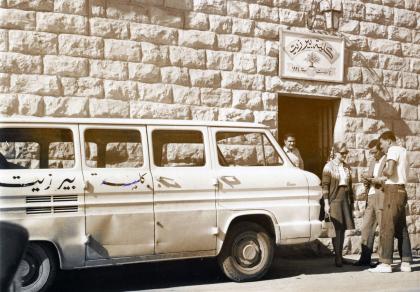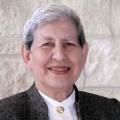The year 1948 was a turning point in the history of Birzeit College. By the spring, the political situation looked precarious, and Birzeit administrators worried that the school year (which normally ended in June) would be interrupted by events that might be triggered by the planned withdrawal of British forces and the end of the Mandate that had been established in 1917. The administrators decided to complete the semester curriculum by April. The graduation ceremony was scheduled for April 30 and was to be held under the auspices of Abd al-Qadir al-Husayni, the chief commander of the Palestinian forces. But that was not to be; he was killed on April 8 by the Haganah (Jewish paramilitary forces) at the battle of al-Qastal while defending that hill on the outskirts of Jerusalem.
Husayni was a popular, well-loved leader, and Birzeit had a special relationship with him because the village served as one of his headquarters. We remember how female students would knit sweaters for his troops; it was one way of expressing their pride in the noble cause he defended so valiantly. The graduation ceremony for the class of 1948 took place as planned on April 30. It was a solemn event held in the hall at the entrance of the main building, presided over by the secretary of the Arab Higher Committee, Emile Ghouri, who was one of Husayni’s deputies.

Birzeit College which was established in 1942 before Al-Nakbeh.
Upon finishing the school year in April, the boarding students, especially those from the coastal areas Jaffa and Haifa, left immediately to return home. Israel was proclaimed on May 15, one day after the British Mandate ended, and many Palestinians from Ramla and Lydda who had either been forced to leave or fled in terror took to the road and walked in the summer heat to Birzeit. The school as well as the churches and mosque opened their doors and offered shelter until it was possible for the refugees either to settle temporarily in tents or to continue their slow, agonizing trek to Ramallah and to towns across the Jordan River.
That summer, our maternal and paternal aunts and uncles who lived in the western part of Jerusalem also took refuge in Birzeit after the horrors of the Dayr Yasin massacre. The dorms were practically empty by then, and thus it was possible to accommodate a lot of the family members on the school premises.
As thousands of refugees arrived in Birzeit, our father understood the importance of documenting their displacement, and he took the initiative to hold a preliminary census of the refugees. Assisted by students and relatives living in Birzeit, he collected a lot of data about the refugees, including their towns of origins, which he later presented to the International Red Cross to help provide assistance to them. This early census data, the first to be collected, earned our father a Red Cross citation.
In September 1948, the school resumed classes. But the student body had changed; by the fall, the students came from Birzeit or the refugee population whose resources were almost nonexistent. The challenge was to keep the school operating despite the financial difficulties. Dwindling enrollment numbers led to the consolidation of the boys’ and girls’ schools into a single coeducational institution. All classes were moved to the main building (our grandfather’s house). A newly acquired building was used as the boys’ and male teachers’ dormitory and living quarters. All boys below the age of twelve resided in the main building in a specially expanded wing.
In March 1951, our dear aunt Nabiha passed away after a short illness. She had been loved by many and was deeply mourned. (Villagers referred to the school as “madrasat al-sitt Nabiha,” a tribute to her influence and dedication.) The administration of the school was assumed by her sister, Nimeh Faris, who proved to be as efficient and skilled as her sister. Our father continued to support her, just as he had Nabiha, while at the same time separately pursuing his political career.
This brief note appears in the 2010 book “Birzeit University: The Story of a National Institution,” which was edited by Ida Audeh. The book chronicles the development of Birzeit University by retelling the stories of those who helped establish it.
In its three chapters, the book presents the history of Birzeit University, from its early beginnings as an elementary school all the way to its present status as a full-fledged university, along with the challenges and obstacles that it faced during its time and its prominent role in the Palestinian community.


